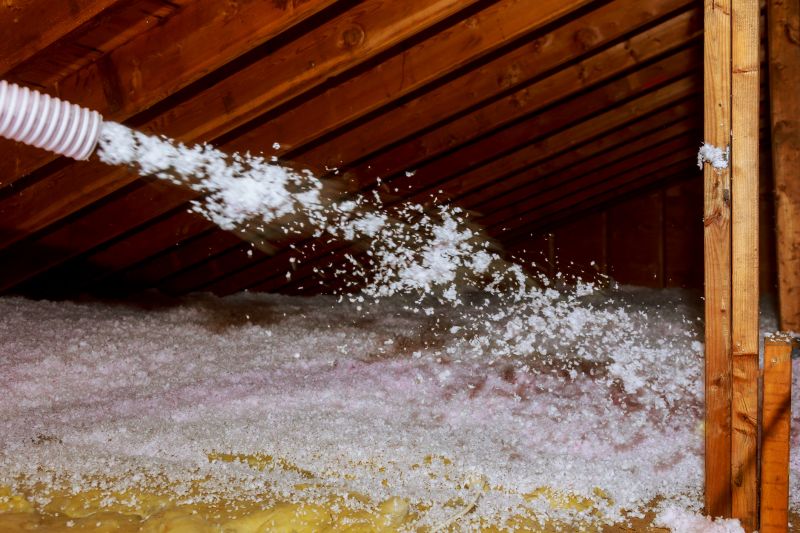Ultimate Selection Of Blown In Insulation Products For Homeowners
Find high-quality blown in insulation solutions crafted to deliver optimal thermal insulation and long-lasting results.
 Blown in insulation products are a versatile and efficient option for enhancing the thermal performance of residential and commercial spaces. These materials are designed to be installed using specialized equipment that disperses the insulation evenly into wall cavities, attics, or other hard-to-reach areas. The primary goal of blown in insulation is to improve energy efficiency by reducing heat transfer, thereby potentially lowering heating and cooling costs. The variety of materials available allows homeowners and contractors to select options that best suit their specific needs and installation environments.
Blown in insulation products are a versatile and efficient option for enhancing the thermal performance of residential and commercial spaces. These materials are designed to be installed using specialized equipment that disperses the insulation evenly into wall cavities, attics, or other hard-to-reach areas. The primary goal of blown in insulation is to improve energy efficiency by reducing heat transfer, thereby potentially lowering heating and cooling costs. The variety of materials available allows homeowners and contractors to select options that best suit their specific needs and installation environments.
Top Overall Option
Universal Blown In Insulation Material
The universal blown in insulation material offers a versatile and adaptable solution suitable for a wide range of applications. Its ease of installation, consistent performance, and compatibility with various blowing equipment make it a popular choice among professionals and DIY enthusiasts alike. Designed to provide reliable thermal resistance, this product can be used in attics, wall cavities, and other hard-to-reach spaces, helping to improve energy efficiency across different building types.
Types of Products For Blown In Insulations
Cellulose Insulation
Made from recycled paper products, cellulose insulation is dense and offers good soundproofing qualities, suitable for various applications.
Fiberglass Blown Insulation
Lightweight and non-combustible, fiberglass is a common choice for attic and wall cavity insulation projects.
Mineral Wool Insulation
Known for its fire resistance and durability, mineral wool is ideal for demanding environments and offers good thermal properties.
Spray-In Cellulose
A sprayable form of cellulose that allows for precise application in irregular spaces and around obstructions.
Loose Fill Fiberglass
Fiberglass in loose fill form, designed for quick installation in attics and wall cavities.
Recycled Paper Insulation
Eco-friendly option composed of recycled paper, offering good insulation properties and ease of handling.
Mineral Fiber Loose Fill
Provides fire resistance and soundproofing, suitable for commercial and residential applications.
Popular Choices
Widely used for its density and soundproofing capabilities, suitable for various building types.
A common choice for attic insulation projects, known for its ease of installation and affordability.
An environmentally conscious option that provides reliable thermal performance.
Offers fire resistance and soundproofing, suitable for both residential and commercial settings.
Provides targeted application in irregular spaces with good thermal properties.
Popular for its lightweight nature and ease of installation in attics and walls.
Designed for quick and effective coverage in various cavities and attics.
Known for fire resistance and durability, suitable for high-demand environments.
Typically, blown in insulation can be composed of cellulose, fiberglass, or mineral-based products. Each material offers unique benefits and considerations, such as fire resistance, moisture resistance, or ease of installation. Cellulose insulation, made from recycled paper products, is often favored for its density and soundproofing qualities. Fiberglass options are lightweight and non-combustible, making them a popular choice for many applications. Mineral-based products can provide enhanced fire resistance and durability, suitable for more demanding environments.
Installation of blown in insulation usually involves using a blowing machine that disperses the material into cavities or attics. This method allows for quick coverage and the ability to fill irregular spaces effectively. Proper installation is critical to ensure uniform coverage and optimal insulation performance. It is also important to consider the R-value, which indicates the insulation's thermal resistance, to meet specific building codes or energy efficiency goals. Regular maintenance and inspections can help ensure the insulation remains effective over time.
When selecting blown in insulation products, it is essential to evaluate factors such as ease of handling, compatibility with existing structures, fire and moisture resistance, and overall cost. Consulting with insulation professionals can help determine the most suitable type and application method for your project. Whether upgrading existing insulation or installing new, the right product can contribute significantly to building comfort and energy savings.
Key Buying Considerations
- Determine the required R-value for your project to ensure adequate thermal resistance.
- Assess the compatibility of the insulation material with your existing structures and installation method.
- Consider fire resistance ratings, especially for areas with strict safety requirements.
- Evaluate moisture resistance properties to prevent issues like mold or degradation over time.
- Check the ease of handling and whether specialized equipment is needed for installation.
- Review the density and coverage capacity of the product to optimize material usage.
- Understand the environmental conditions of the space to select the most suitable material.
- Compare the cost per square foot or per unit volume to stay within your budget.
- Look into the product’s soundproofing qualities if noise reduction is a priority.
- Verify the product’s compliance with local building codes and safety standards.
- Consider the long-term maintenance and whether the insulation requires periodic inspection.
- Research the availability of the product in your area for timely project completion.
- Think about potential health and safety considerations during installation, such as dust or irritants.
- Determine if the product is compatible with other insulation types or retrofit projects.
- Assess the environmental conditions that might affect insulation performance, such as humidity or pests.
This page contains affiliate links. We may earn a commission if you make a purchase through these links, at no additional cost to you.
